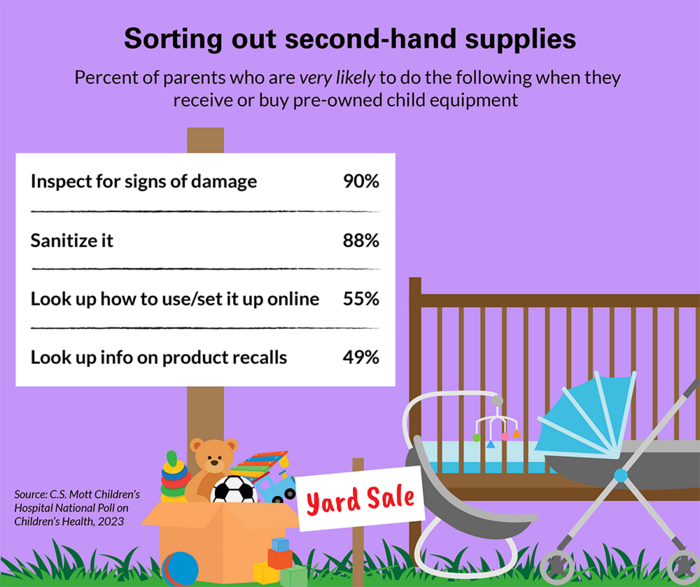Cribs, strollers and other infant and child equipment can be expensive and most families in a new national poll agree that it’s wasteful to buy these items new when they’re needed for such a short time.

Credit: University of Michigan Health C.S. Mott Children’s Hospital National Poll on Children’s Health
Cribs, strollers and other infant and child equipment can be expensive and most families in a new national poll agree that it’s wasteful to buy these items new when they’re needed for such a short time.
But while half of parents say they have used pre-owned equipment for babies and young children, two in three acknowledge that it’s difficult to always know whether it’s safe for their child, according to the University of Michigan Health C.S. Mott Children’s Hospital National Poll on Children’s Health.
“Used child essentials are often more cost-effective, environmentally friendly and convenient,” said Mott Poll co-director Sarah Clark. “However, many parents in our poll weren’t completely confident they could identify safety concerns, such as unsafe wear and tear, recalls or hygiene issues.”
Half of parents polled say they are only comfortable using used infant and child equipment from family or close friends while a little less than half are also OK with items bought at resale shops and yard sales.
Parents most commonly used pre-owned cribs and highchairs, followed by outdoor play structures, strollers, playpens and bath seats, according to the poll report, which is based on responses from 932 parents with at least one child aged 0-7 surveyed in February 2023. Parents are least likely to report using second hand infant car seats or booster seats.
“Regardless of whether they receive the item from someone they know well or from a garage sale, parents should take diligent steps to make sure the equipment meets current safety standards and is safe for their child,” Clark said.
“Parents should keep in mind that safety regulations are constantly evolving as research identifies features that pose a risk of injury,” she added. “This is particularly important when it comes to cribs, one of the most common types of pre-owned equipment. It is likely that some parents using pre-owned cribs may not be aware of how safety standards have changed.”
Most parents say that when they receive or buy pre-owned equipment, they are very likely to inspect it for signs of damage and sanitize it. But just half of parents are as likely to do an Internet search for instructions on how to set up and use the equipment or for information about product recalls.
“If parents don’t properly follow assembly instructions, cribs, strollers and playsets can collapse or malfunction, potentially causing serious injuries to the child,” Clark said.
“Before allowing a child to use a pre-owned item, it’s also essential to check for product recalls, which mean a manufacturer has asked customers to return or stop using the product due to a discovered safety hazard.”
Four percent of parents polled are not comfortable using any pre-owned equipment and three-quarters say they’d prefer to buy new equipment to make sure it’s safe for their child.
But budget concerns can be a barrier, especially since families often require duplicate pieces of equipment to support their child’s sleep, transportation, and other daily activities at grandparents’ or babysitters’ homes.
Parents with household incomes under $100,000 are more likely to say they have used pre-owned equipment compared to those over $100,000 (58% vs 48%.)
Most parents also say they themselves have donated or sold child health and safety equipment, most often to a family member or friend (74%) or a charitable organization (52%), as well as at a garage sale (35%) or to a children’s resale shop (33%). Another 19% say they have never shared or sold pre-owned equipment.
“Before passing on an item to another family, parents should ensure it’s safe and in good working order,” Clark said. “If not, parents should dispose of the equipment to avoid risking injury of another child.”




